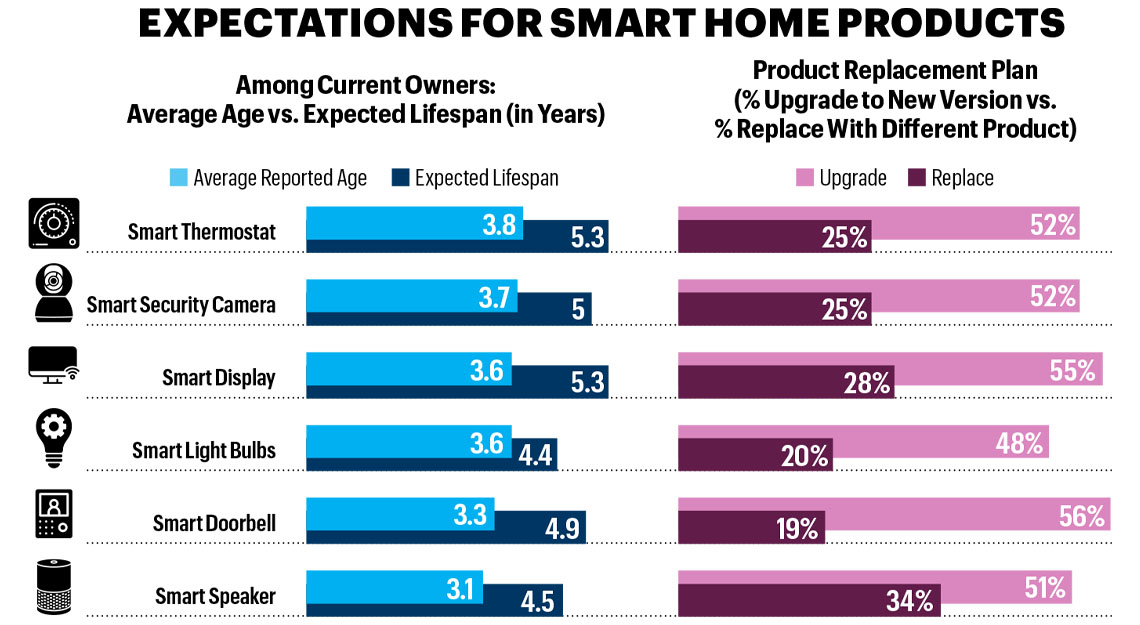Product Lifecycles Shrinking
February 3, 2023

- Author: Steve Koenig, CTA Vice President, Market Research
How long do consumers expect technology products to last? The answer may surprise you. The ways in which consumer expectations have changed over the past 20 years may surprise you even more.
What shapes consumer perceptions of how long products last?
As technology products evolved from analog to digital, and again from connected to intelligent, or smart, consumer expectations around longevity and replacement cycles have shortened. The reasons for the shift are broad and multi-faceted but generally relate to the roles technology plays in society, the ever-increasing pace of innovation, product commoditization, and even pseudo-cultural dynamics, such as consumerism.
Through CTA product lifecycle research conducted in 2002, 2011, 2019 and most recently in 2022, one observation holds true: When it comes to product lifecycles, consumer opinions are not uniform across categories, and they become more diverse as new categories emerge and develop.
CTA’s 2022 Consumer Technology Product Lifecycle Study (Oct. 2022) explores current consumer expectations of technology longevity across multiple device categories. The analysis examines factors that lead to end of life, replacement frequency, and methods of disposal or recycling. Here are some current observations and product lifecycle trends that have changed over time.
Replacement Drivers
Importantly, the 2022 study confirms results from previous CTA research concerning replacement and life expectancy across device categories. Consistently, consumers generally anticipate using devices until they stop working or malfunction; however, emerging technologies present an exception to that rule. Consumers are more likely to replace emerging technology devices with a newer version before an existing device quits. Today, smart home products and wearables (e.g., smartwatches) have the highest anticipated upgrade rate among owner households: On average, 52% will likely upgrade to the next-gen version of their smart home product and 55% will upgrade wearables.
Mature Vs. Emerging Tech
Another consistent trend is that devices in mature categories are expected to last longer versus emerging technologies. Perhaps that idea rises from the notion that proven, or mature, products will last longer versus unproven or emerging technologies. Regardless, CTA’s 2022 study found that TVs have the longest expected lifespan of any consumer tech product at 6.5 years, followed by desktop computers (5.7 years), multi-function printers (5.6 years), and smartphones (4.8 years). While TVs currently have the longest expected lifespan among technology products, overall their life expectancy has decreased dramatically. In 2011, consumers expected TVs to last nearly nine years, according to CTA’s CE Product Lifecycle Study.
Smartphones tell an interesting story of how expectations of product life lengthen as a category matures. In 2011, when smartphones were a relatively young product category and the 4G LTE wireless network was brand new, consumers believed their mobile handsets would last just under four years. Now, 11 years later, CTA’s 2022 study reveals that consumers expect smartphones to last nearly five years.
Sustainability Concerns
As we consider technology product lifecycles, it is equally important to consider what will happen to devices and accessories when they are no longer wanted or used. Consumers today have many options to dispense with their unwanted tech, including trade-ins, giving it away, recycling, or the trash bin. Meanwhile, consumers are just as likely to throw away accessories (24%) as they are to recycle them (23%).

Join our community of innovators and shape the future of technology.



